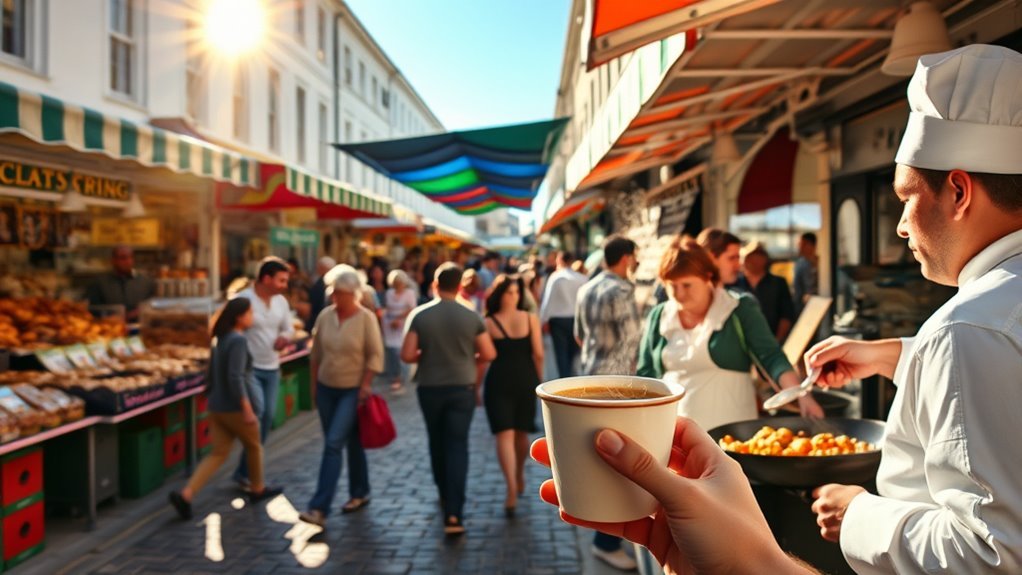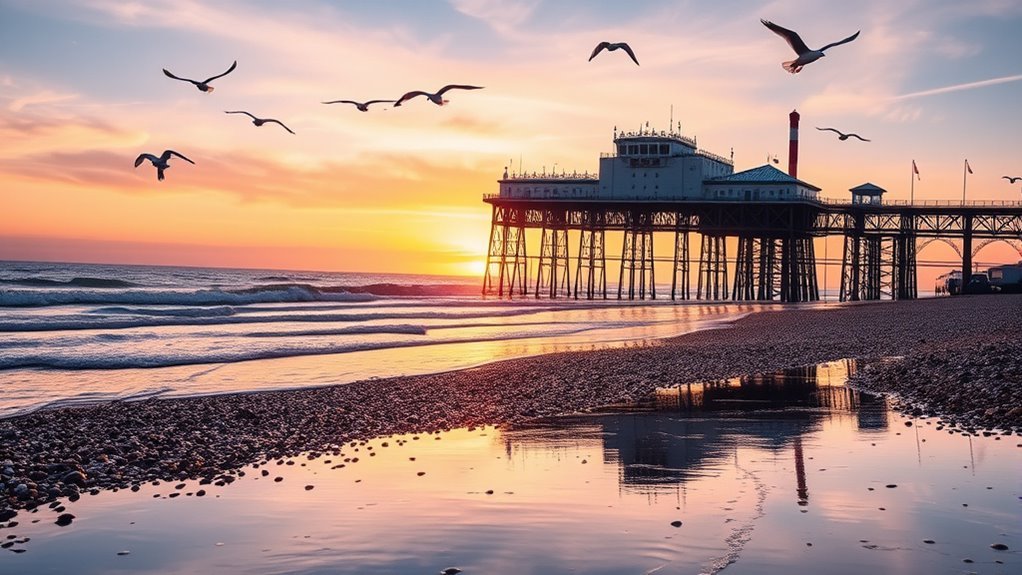Imagine strolling through the streets of Brighton, England, where history merges with modern vibrancy. The city’s charm lies in its stunning coastal scenery and thriving cultural scene, capturing the hearts of millions. You’ll find a rich tapestry of attractions, from the iconic Royal Pavilion to the bustling Brighton Palace Pier. With its diverse population and dynamic creative sectors, Brighton offers a unique experience. Curious about what else this lively city has to offer?
Key Takeaways
- Brighton, a coastal city in England, is renowned for its vibrant arts scene and historic landmarks like the Royal Pavilion.
- Known as the UK’s unofficial gay capital, Brighton has a significant LGBTQ+ community and a diverse cultural atmosphere.
- The city’s economy thrives on tourism, creative industries, and a dynamic workforce, attracting numerous start-ups and innovation.
- Brighton’s temperate climate features mild winters and cool summers, offering scenic views between the South Downs and the English Channel.
- The city faces social challenges like homelessness, but is supported by community initiatives and the Homeless Bill of Rights.
Toponymy and Historical Development

As you explore Brighton’s rich history, you’ll discover its earliest name, Bristelmestune, recorded in the Domesday Book of 1086. This name evolved to Brighthelmstone by the 14th century, eventually becoming Brighton by 1660.
The town’s historical development took a significant turn in the mid-18th century when Richard Russell advocated for the health benefits of seawater. His promotion brought a wave of tourists seeking wellness, setting the stage for Brighton’s transformation into a fashionable resort.
The Prince Regent’s patronage in the 1780s and the construction of the opulent Royal Pavilion further elevated Brighton’s status. As a result, Brighton experienced rapid growth, particularly after the London and Brighton Railway arrived in 1841, drawing more visitors and residents alike.
Geography and Climate
Brighton’s coastal location, situated between the South Downs and the English Channel, offers stunning views, but also presents challenges.
The temperate climate brings mild winters and cool summers, yet it doesn’t prevent occasional flooding from the seasonal Wellesbourne River.
Coastal erosion remains a concern, especially during severe storms that have historically battered its cliffs.
Coastal Location Highlights
Brighton’s stunning coastal location on the southeastern coast of England offers more than just breathtaking views. Nestled directly on the English Channel, the city is blessed with over 7 miles of Brighton Beach, where the pebbly shoreline meets the sea.
You’ll find the iconic chalk cliffs to the east, with the East Cliff towering 24 meters above sea level, providing a dramatic backdrop against the azure waters. These geographical features make Brighton a popular seaside resort, drawing visitors who are enthusiastic to enjoy both the natural beauty and vibrant atmosphere.
While the average annual rainfall, around 740mm, contributes to the lush landscape, it also means you might experience the seasonal river Wellesbourne during heavy rains, which occasionally causes flooding in certain areas.
Seasonal Weather Patterns
When you visit Brighton, you’ll experience its temperate climate, marked by cool summers and mild winters with frequent rain. The seasonal variations are quite noticeable, with summer bringing more sunshine and mild temperatures.
You’ll find that the average rainfall on the seafront is about 740mm (29 inches) annually. Late autumn and winter are typically the wettest times of the year, making those months ideal if you enjoy a rainy atmosphere.
However, be prepared for heavy rainfall during these periods, which can sometimes be intense. Such precipitation patterns can change your plans, but they also contribute to Brighton’s lush landscapes and vibrant natural beauty.
Make sure to pack accordingly and embrace the unique weather Brighton offers.
Erosion and Flooding Concerns
While enjoying Brighton’s unique weather, it’s important to be aware of the geographical challenges that accompany it. The temperate climate and frequent rainfall contribute to erosion, especially along the East Cliff, which stands 24 meters above sea level. The sea air accelerates this process, particularly after historical storms like those in 1703 and 1987. Flooding is another concern, with the seasonal Wellesbourne River playing a significant role. Although it was culverted in 1793, heavy rains can still cause it to overflow, impacting urban areas.
Here’s a quick overview:
| Challenge | Cause/Effect |
|---|---|
| Erosion | Sea air, storms, and coastal land degradation |
| Flooding | Wellesbourne overflow, intense rainfall |
| East Cliff | Vulnerable to erosion, 24 meters above sea level |
| Historical Storms | 1703, 1806, 1987, increased erosion/flooding |
Demographics and Cultural Significance
Despite its modest size, Brighton and Hove stand out for their distinctive demographic profile and cultural significance.
You’ll find a city bustling with a vibrant cultural scene, heavily influenced by its diverse communities. With an estimated population of 277,965 in 2017, Brighton boasts a significant number of adults aged 20–44, creating a dynamic and youthful atmosphere.
Renowned as the unofficial gay capital of the UK, Brighton’s LGBT community is vibrant and welcoming, with 11–15 percent identifying as lesbian, gay, or bisexual. It has the highest percentage of same-sex households in the UK and previously led in civil partnership registrations outside London.
The city’s inclusivity and creativity make it one of the happiest places to live, with iconic landmarks like the Royal Pavilion enhancing its charm.
Economy and Commerce

Brighton and Hove’s vibrant cultural scene naturally extends into its bustling economy and commerce.
You’ll find that tourism plays a significant role here, drawing millions of visitors annually who boost local businesses and the hospitality industry.
But that’s not all—Brighton’s economy also shines through its creative sectors. With a young, dynamic workforce, the city is a magnet for start-ups and tech companies, especially those in the digital and creative industries.
This innovation is further fueled by the University of Sussex and other educational institutions, which provide a steady stream of skilled graduates.
Meanwhile, Brighton’s retail landscape, highlighted by The Lanes and North Laine, offers a unique shopping experience with independent shops that enrich the local economy.
Attractions and Landmarks
When you explore Brighton, you’ll discover a wealth of attractions and landmarks that capture the city’s charm and history.
Start your journey at the Royal Pavilion, a former royal residence known for its stunning Indo-Saracenic architecture. Inside, you’ll find a museum filled with fascinating art collections and stories from Brighton’s past.
Next, head to the Brighton Palace Pier, where you can enjoy thrilling amusement rides and classic arcade games, all set against a lively seaside backdrop.
Don’t miss the Brighton Museum and Art Gallery, where diverse exhibits showcase local history, fashion, and art.
For a shopping adventure, wander through The Lanes, filled with quaint boutiques and antique shops.
- Royal Pavilion: Unique architecture and art.
- Brighton Palace Pier: Amusement rides and games.
- Brighton Museum and Art Gallery: Varied exhibits.
- The Lanes: Shopping treasure trove.
Food, Drink, and Culinary Scene

When you’re in Brighton, you’re in for a culinary adventure with its diverse food offerings that span from Mediterranean to Argentinean cuisine.
Popular dining destinations like Baqueano and Constantinople Restaurant showcase the city’s commitment to both flavor and sustainability.
Don’t miss exploring Brighton Open Market for a taste of the city’s multicultural palate and local seafood delights.
Diverse Culinary Offerings
Although often overshadowed by its vibrant nightlife and eclectic arts scene, Brighton’s diverse culinary offerings are a standout feature of the city. You’ll find a diverse culinary scene brimming with independent restaurants that cater to every palate.
Whether you’re craving high-quality seafood or vegetarian-friendly options, Brighton delivers. Many eateries embrace sustainable practices, prioritizing local ingredients to craft exquisite dishes.
Venues like Shelter Hall provide an exceptional mix of local produce and panoramic views, enhancing your dining experience. Don’t miss out on food tours that reveal hidden culinary gems and let you immerse yourself in Brighton’s indie food culture.
- Explore independent eateries for unique flavors.
- Enjoy panoramic views at Shelter Hall.
- Discover sustainability-focused restaurants.
- Join a food tour for an insider’s experience.
Popular Dining Destinations
Brighton’s culinary scene is a vibrant tapestry of flavors, where popular dining destinations await your exploration. Near the Brighton Museum and Art Gallery, you’ll discover a range of dining options that promise to tantalize your taste buds.
Start with Baqueano, an Argentinean steakhouse earning a perfect 5.0 rating from 1,833 reviews and craving Mediterranean? Constantinople Restaurant and ETCI Kitchen, both boasting 4.9 ratings, offer exquisite Turkish and barbecue delights.
For a taste of India, Jamun Restaurant, also rated 4.9, serves delectable vegetarian-friendly dishes. Don’t miss Kusikuy Peruvian Cuisine & Pisco Bar, a 4.9-rated gem known for healthy Latin dishes.
Brighton’s food scene thrives with local markets and shops, ensuring fresh, sustainable, and diverse culinary experiences.
Religion and Spirituality
Despite its vibrant cultural scene, Brighton stands out as one of the least religious areas in the UK, with 42 percent of its population identifying as having no religion. This secular trend surpasses the national average, earning Brighton the nickname “the UK’s most Godless city.”
Yet, religion still plays a role in the community. Christianity remains the largest religion, with 43 percent of residents, while Islam follows at 2.2 percent. Curiously, in the 2001 census, 2.6 percent identified as Jedi Knights, a quirky indication of Brighton’s unique spiritual flair.
To explore Brighton’s spiritual landscape:
- Attend a local church or mosque service.
- Visit spiritual gatherings or meditation groups.
- Engage with community-led spiritual discussions.
- Explore alternative beliefs, such as those of the Jedi Knights.
Homelessness and Social Issues

When you look at Brighton’s homelessness rates, you’ll notice it ranks third highest in England, with several neighborhoods facing significant social challenges.
Understanding the causes behind these statistics, such as economic deprivation in areas like East Brighton and Moulsecoomb, is vital.
Thankfully, the city’s adoption of the Homeless Bill of Rights highlights local efforts to support and improve conditions for those affected.
Homelessness Rates and Causes
Homelessness in Brighton and Hove is a pressing issue, where one in 78 people is reported as homeless, making it the third highest rate in England. You might wonder why this is happening. Areas like East Brighton and Moulsecoomb & Bevendean are in the top ten percent nationally for deprivation, really driving the homelessness crisis.
This high concentration of deprivation contributes greatly to social issues. Additionally, Brighton’s urban secularism trend, with 42 percent of the population professing no religion, could impact the social support systems for those experiencing homelessness.
- Deprivation in areas like Whitehawk exacerbates social issues.
- The Homeless Bill of Rights was adopted in 2021.
- Urban secularism might alter traditional support networks.
- Moulsecoomb ranks high nationally for deprivation.
Community Support Initiatives
Addressing homelessness in Brighton and Hove requires more than awareness; it demands action and support from the community. With one in 78 residents experiencing homelessness, local organizations play an essential role.
Brighton and Hove, the first UK city to adopt the Homeless Bill of Rights, underscores the importance of ensuring dignity and rights for homeless individuals. Community support is critical in areas like Whitehawk, Moulsecoomb, and Hollingbury, where deprivation is most acute.
Despite being one of the least religious regions, the city’s dedication to tackling social issues shines through. Various initiatives offer shelter, food, and health care, demonstrating the community’s commitment to alleviating these challenges.
You can make a difference by supporting these efforts and fostering a more inclusive society.
Transportation and Accessibility
Although Brighton is a vibrant city on its own, its transportation links make it even more accessible and appealing.
Located within the unitary authority of Brighton, you’ll find easy access to this seaside gem, whether you’re traveling from London or abroad. With regular trains from London Victoria and London Bridge, you can reach Brighton in about an hour.
If you’re an international traveler, London Gatwick Airport is just a quick 30-minute train ride away. For those on a budget, National Express coaches offer a two-hour journey from London.
Once in the city, Brighton & Hove Buses provide extensive local routes, while bike-friendly paths and rental services promote eco-friendly travel.
- Trains: Quick one-hour ride from London.
- Airport: Only 30 minutes from Gatwick.
- Coaches: Affordable two-hour option.
- Buses/Bikes: Local connectivity and green travel.
Sports and Recreation

Plunge into Brighton’s dynamic world of sports and recreation, where excitement and activity are always at the forefront. Start with the thrill of football at Brighton & Hove Albion F.C., a Premier League staple. Rugby fans can cheer for the local Brighton & Hove Rugby Club. For a scenic escape, head to the South Downs National Park. Its trails beckon hikers and cyclists, offering endless recreational activities against stunning backdrops.
Down by the sea, Brighton’s vibrant beachfront teems with energy. Try beach volleyball, paddleboarding, or jet skiing for a thrilling day out. Horse racing at Brighton Racecourse adds to the city’s sporting allure. Don’t miss the annual Brighton Marathon, a major UK event drawing countless runners and spectators.
| Activity | Location | Feature |
|---|---|---|
| Football | Brighton & Hove Albion F.C | Premier League Action |
| Rugby | Brighton & Hove Rugby Club | Local Matches |
| Hiking/Cycling | South Downs National Park | Scenic Trails |
| Beach Sports | Brighton Seafront | Volleyball, Paddleboarding |
| Horse Racing | Brighton Racecourse | Sea Views |
Conclusion
You’ve just explored Brighton, a city where history and modernity beautifully intertwine. With its stunning coastal views, inclusive atmosphere, and vibrant cultural scene, it’s no wonder Brighton is a beloved destination. Whether you’re drawn to its iconic landmarks, diverse culinary offerings, or welcoming community, there’s something here for everyone. Despite facing some social challenges, Brighton’s spirit remains unyielding. So, come and experience the charm and warmth that make Brighton one of the happiest places to live.
FAQs
1. What Is Brighton, England, Famous For?
You’ll find a lively LGBT+ scene, the iconic Royal Pavilion, and bustling Brighton Palace Pier. Enjoy exploring The Lanes for unique shopping experiences. Relax on the pebble beach or indulge in watersports and beachside events year-round.
2. Is Brighton an Expensive Town?
You’re exploring an expensive area—property and rental prices trend high, driven by demand and attractions. Dining and nightlife can stretch your budget, especially near popular spots. However, you can find budget-friendly options if you look carefully.
3. Is Brighton, England, a Nice Area?
You’d find the area inviting with its lively cultural scene, historical landmarks, and mild climate. Despite facing some challenges, the community actively works to improve, making it a desirable place to visit or live.
4. Who Is the Most Famous Person From Brighton?
You’re wondering about the most famous person from there, aren’t you? It could be Sir Arthur Conan Doyle with his iconic Sherlock Holmes character or perhaps Kate Winslet, an Oscar-winning actress. Each has left a significant mark.

